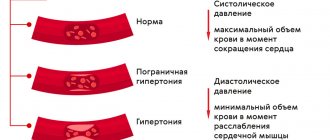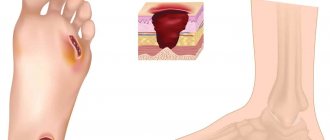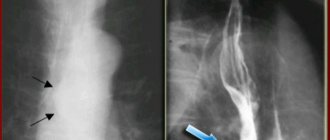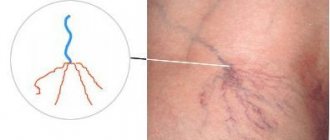The circulatory system is necessary to fully saturate all cells of the body with nutrients and oxygen. The return movement of blood to the heart is called venous outflow. When this process is disrupted, the return of valuable fluid from the central nervous system to the heart muscle fails. In such a situation, the doctor diagnoses “venous dysgemia.” All “waste” blood moves back through the veins, so in a situation where any obstacles arise in its path, stagnation begins to appear. In places of inhibition, the blood gradually destroys the walls of the veins, trying to find new paths for its movement. If we examine the circulatory system as a whole, then its arterial component is structured almost the same in all people, but the venous part differs, sometimes significantly.
Causes of pathology
There are three locations of stagnation, so venous dyshemia has three types:
- the problem originated in the brain;
- in the plexus of vertebrae;
- in the ECA basin area.
The main reason for the development of pathology is hereditary predisposition. The disease manifests itself as dysfunction of the cardiovascular system or musculoskeletal system; problems in bone joints with cartilage are likely. This type of disease can manifest itself even in newborns.
The most recent studies confirm that in children the disease more often appears due to the structural features of the cervical spine. This is usually a special curvature or tortuosity of the bone canal. The problem may be congenital or provoked by a birth injury in the area of 1–2 vertebrae in the neck. In such a situation, treatment is necessarily aimed at completely restoring the integrity and functions of the bones of this section, guaranteeing correction of the child’s posture.
Violation of venous outflow. Symptoms and complications.
The main symptom of the disease is a condition that patients themselves describe as a state of stupor and lethargy, “as if someone had hit them on the head with a pillow.” These symptoms are usually localized as heaviness in the back of the head, because this is where all the venous pathways converge, which then flow into the internal jugular vein system.
One of the most annoying complications of central venous insufficiency is tinnitus: the disease creates conditions for stagnation in the inner ear, which leads to irritation of the nerve, commonly called the auditory nerve, and as a result - to the appearance of tinnitus. In official medicine, neurologists deal with this condition, but by and large, drug therapy is ineffective in this case, unlike osteopathic treatment.
The fact is that the most common cause of chronic venous insufficiency of the brain is tension in the suboccipital region. This may be a consequence of birth or domestic trauma, especially the so-called. whiplash injury to the neck.
Among the chronic causes of impaired venous outflow is prolonged work at the computer in a slouched position with the head extended towards the screen.
Diseases that can provoke the development of pathology
There are a number of diseases that can provoke the appearance of venous dysgemia in a child:
- Stenosis. A characteristic phenomenon of pathology is vasoconstriction, due to which the veins gradually begin to collapse. As a result, the natural process of blood outflow is disrupted, and vein blockage develops. It is incredibly difficult to identify the problem, since narrowing of blood vessels by less than half does not give any unpleasant symptoms.
- Deformation of organs that impede normal blood flow, pinching of valves or bridges. In such a situation, the direction of blood flow may be changed. It happens that a child is already born with an abnormal structure of the venous system - complete or partial closure of blood vessels.
- Even diseases completely unrelated to the blood flow can provoke venous dysgemia - problems in the spine, the presence of cancerous tumors, or previous trauma suffered by the child.
- Not the last place on the list is occupied by bad habits - overeating, teenage smoking, drinking alcoholic beverages.
- Osteochondrosis, as well as pathologies of the thyroid gland, are not the cause of improper venous outflow. These problems become a consequence of such a problem.
Symptoms of venous dysgemia sometimes appear immediately after the baby is born due to problems that appear during the perinatal period of fetal development.
Symptoms
The first and main sign of a problem is the occurrence of acute pain where the blood outflow is blocked. Such points can be easily identified through palpation on the chest, neck, shoulders and head. Painful discomfort is caused by the fact that stagnant blood gradually destroys the tissues surrounding it, trying to “break through” the road.
Children's venous dysgemia is often accompanied by dizziness and spontaneous headaches. The baby often has a fever, causing a sharp increase in temperature. In an advanced state, the severity of symptoms is much more serious, it is manifested by the following parameters:
- violation of natural coordination of movement;
- dysfunction of the main sensory organs;
- performing involuntary movements;
- development of complete or partial paralysis;
- convulsions;
- nosebleeds;
- constant sensations of pain;
- impaired motor skills, slurred speech.
At the very beginning of the development of the disease, it practically does not manifest itself at all. Only sometimes the child complains of short-term impairment of motor coordination and headaches. In addition, venous problems cause metabolic disorders and lack of oxygen. These disruptions provoke constant chills, surges in blood pressure, and the limbs periodically go numb.
Venous system of the brain, lesion syndromes
The veins of the brain are divided into superficial and deep. Superficial veins, located in the pia mater, collect blood from the cortex and white matter, deep veins - from the white matter of the hemispheres, subcortical nodes, ventricular walls and choroid plexuses. The veins of the dura mater pass together with the arteries in the thickness of the shell and form a significant venous network. All veins carry blood to the venous blood collectors - the venous sinuses of the dura mater, located between its two leaves. The main ones are: the superior longitudinal sinus, passing along the upper edge of the large falciform process; the inferior longitudinal sinus, located along the lower free edge of the large falciform process with the tentorium of the cerebellum; transverse sinus - the widest of all, located on the sides of the internal occipital bone thickening; cavernous sinus located on the sides of the sella turcica. Between the left and right cavernous sinuses, the intercavernous sinuses, anterior and posterior, pass transversely, thus forming a circular sinus around the pituitary gland. The outflow of blood from the cranial cavity occurs through the internal jugular vein, partly through the vertebral vein and emissaries - venous graduates located inside the flat bones of the skull and connecting the venous sinuses of the dura mater with the diploic veins and with the external veins of the head. When the normal outflow of blood from the brain is disrupted, the development of picture of venous stagnation. Its causes may be cardiac and pulmonary failure, compression of extracranial veins - internal jugular, innominate and superior cava, brain tumors, traumatic brain injury, thrombosis of the veins and sinuses of the brain, compression of veins with craniostenosis and cerebral hydrocele, hanging, asphyxia of newborns. Thrombosis cerebral veins can occur without previous inflammation (phlebothrombosis) or against the background of inflammation (thrombophlebitis), but distinguishing them by clinical signs is difficult. Thrombosis of superficial cerebral veins
.
The clinical picture is characterized by a combination of neurological symptoms with signs of an inflammatory, usually infectious process (fever, inflammatory reaction of the blood, and sometimes of the cerebrospinal fluid). The disease almost always begins with a headache
, which is often accompanied by nausea and vomiting. Quite often, consciousness is impaired (sometimes with psychomotor agitation), and against this background, focal brain symptoms arise (paresis or paralysis of the limbs, aphasia, focal or general epileptic seizures, etc.). Lability of focal symptoms is characteristic, due to the migration of the process from one venous trunk to another. The morphological substrate causing the symptoms described above are hemorrhagic infarctions in the gray and white matter of the brain, intracerebral and subarachnoid hemorrhages, ischemia and cerebral edema.
The overwhelming majority of cases of thrombophlebitis of the superficial cerebral veins are observed in the postpartum period. It should be borne in mind that in such cases, hemorrhagic cerebrospinal fluid can be obtained with a lumbar puncture. Thrombosis of the deep veins of the brain and the great cerebral vein (veins of Galen). The clinical picture is particularly severe.
Patients are usually in a comatose state, general cerebral phenomena, signs of dysfunction of brainstem and subcortical structures are pronounced, intravital diagnosis is extremely difficult; importance should be given to the development of brain symptoms against the background of thrombophlebitis of the extremities or inflammatory foci in the body, for example, in the postpartum period, after an abortion, with diseases of the ears and paranasal sinuses, and with various infectious diseases.
Venous sinus thrombosis
characterized by a sharp headache, meningeal symptoms, swelling of the subcutaneous tissue of the face or scalp, sometimes fever, changes in consciousness (from stupor to coma). There is congestion in the fundus. In the blood there is leukocytosis, the cerebrospinal fluid is clear or xanthochromic, sometimes with slight pleocytosis. Focal neurological symptoms correspond to the location of the affected sinus.
Thrombosis of the sigmoid transverse sinus
occurs most often and is a common complication of purulent otitis or mastoiditis. It is characterized by pain and swelling of the soft tissues in the mastoid area, pain when chewing and turning the head in a healthy direction. Usually accompanied by severe septic symptoms. When the inflammatory process moves to the jugular vein, there are signs of damage to the IX, X and XI nerves.
Cavernous sinus thrombosis
(the most common variant of cerebral venous pathology) is usually a consequence of a septic condition, complicating purulent processes in the face, orbit, ear and paranasal sinuses. Against the background of pronounced inflammatory symptoms, there are clear signs of impaired venous outflow: swelling of the periorbital tissues, increasing exophthalmos, chemosis, swelling of the eyelids, congestion in the fundus, sometimes with the development of optic nerve atrophy. Most patients experience external ophthalmoplegia due to damage to the III, IV, VI cranial nerves, ptosis, pupillary disorders, corneal opacity are observed, due to damage to the superior branch of the trigeminal nerve - pain in the area of the eyeball and forehead, sensitivity disorders in the area of the supraorbital nerve.
Thrombosis of the cavernous sinus can be bilateral; in such cases, the disease is especially severe, and the process can spread to adjacent sinuses. There are cases of cavernous sinus thrombosis with a subacute course and cases of aseptic thrombosis, for example, in hypertension and atherosclerosis.
Thrombosis of the superior longitudinal sinus
. The clinical picture varies depending on the etiology, rate of development of thrombosis, its localization within the sinus, as well as the degree of involvement of the veins flowing into it. Cases of septic thrombosis are especially difficult. With thrombosis of the superior longitudinal sinus, overflow and tortuosity of the veins of the eyelids, root of the nose, temples, forehead, crown (“head of the jellyfish”) with swelling of this area is observed; Nosebleeds often develop, and pain is noted upon percussion of the parasagittal region. The neurological syndrome consists of symptoms of intracranial hypertension, convulsive seizures, often starting from the foot; sometimes lower paraplegia with urinary incontinence or tetraplegia develops.
Marantic sinus thrombosis occurs in debilitating diseases, usually in young children and the elderly.
Infectious thrombosis of the cerebral veins and sinuses can be complicated by purulent meningitis, encephalitis, and brain abscess.
Treatment.
Antibiotics, sulfonamides, anticoagulants, diuretics. In all cases, sanitation of the primary source of infection is necessary. In case of thrombosis and purulent inflammation of the sigmoid sinus, urgent surgical intervention is indicated, which is performed in the area of the primary lesion (in case of mastoiditis - on the mastoid process) and in the sinus area (opening it, removing the blood clot); in cases complicated by a brain abscess (usually in the cerebellum and temporal lobe), the abscess cavity is emptied. The prognosis is especially serious for septic sinus thrombosis. When treating cavernous sinus thrombosis, it is very important to promptly open ulcers located in the face, orbit, nasal cavity, paranasal sinuses, etc.
Diagnostics
It is impossible to prescribe the correct treatment for a patient without conducting a full examination to identify the main causes that provoked the appearance of the pathology. Nowadays, many methods have been developed, there is modern equipment that allows you to almost accurately determine that a child has venous dysgemia. The most effective method is Doppler ultrasound (USD).
It is usually quite difficult to immediately make an accurate diagnosis. Parents should first visit a neurologist, especially when the baby is constantly crying or has nervous behavior.
Even after clarifying the nature of the disease, it is still not easy to develop precise treatment tactics that would eliminate not the pathology itself, but at least its main symptoms. Because of this, doctors hesitate to make a diagnosis, because the problem that has arisen is a consequence of a certain disease that must be eliminated first of all.
Treatment of venous outflow disorders
Typically, patients are prescribed the same drugs - venotonics - as for chronic venous insufficiency of the lower extremities.
However, a much more effective method is osteopathy: there are many osteopathic techniques that affect the possibility of improving the outflow from the venous sinuses, as well as techniques that can affect the suture between the occipital and temporal bones, where the outlet of the jugular vein is located, through which 95% of the discharge occurs. blood from the head.
Using these methods, an osteopathic doctor can improve blood flow and outflow of venous blood, which will quickly and permanently alleviate the condition of a patient suffering from chronic cerebral venous insufficiency.
Vladimir Bykov, leading osteopathic doctor (chiropractor, neurologist) Osteopolyclinic.
The article is located in the sections: OSTEOPATHY FOR ALL NEUROLOGY AND MANUAL THERAPY
Phytotherapy
When a child has venous dysgemia in the area of the spinal plexuses, the doctor prescribes healing baths. Viburnum berries, sage herbs, chamomile or elderberry are added to the water.
Other recommendations
The baby, when he realizes what is happening to him, needs to be taught to lead an active lifestyle. The harm of certain habits must be explained to him so that he understands that they are dangerous to his life. The child should be taught to play sports.
Running and long walks help overcome venous dysgemia. It is useful to introduce a teenager to yoga. But as the disease progresses, medical consultation is required to help optimize the expected physical activity. It is better not to visit the sauna, since a sharp change in temperature, despite the stimulation of blood flow, negatively affects blood vessels that are weakened by the disease.










